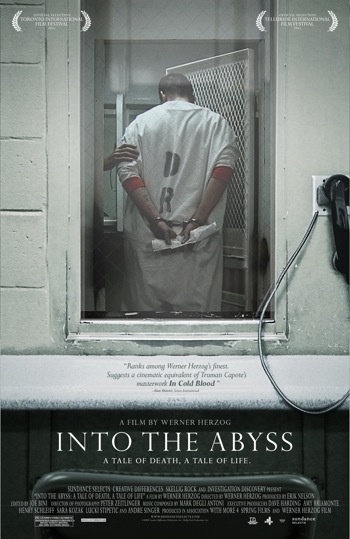Review: Into The Abyss (2011)
On August 7, 2012, Marvin Lee Wilson was executed by lethal injection in Huntsville, Texas. What drew attention to this particular execution was that Marvin Lee Wilson had an IQ of 61, making him legally mentally retarded which, through a supreme court ruling (Atkins v. Virginia), makes him ineligible for the death penalty. However, the language of the ruling allows the state to define mental retardation, to which Marvin Lee Wilson did not fall under in Texas’ definition. This highlights the moral gravity, circumstances of the individual, and ambiguous definition of the death penalty in a developed nation such as the United States. Such highlights has also become the focal points for Werner Herzog’s documentary Into The Abyss.
Herzog divides his film into several parts with distinct headings creating a sense of theatricality that is trademark of his films. Abyss begins with “Prologue” as he discusses with a death row chaplain the biblical reasoning for capital punishment, asking “Why does God allow capital punishment?” The chaplain answers honestly with an “I don’t know” thus setting a tone of ambiguity and nuance that circles the central death row inmate and the town of Conroe,Texas from which the inmate originates. Herzog’s theatricality extends to the film’s camera work with long shots of the town, showing decrepit gas stations and homes; financial distress and restlessness. It is slow and meditative but creates a sense of tension that gives the documentary weight.
Herzog’s choice to interview a citizen of Conroe paints a rich backstory for the death row inmate and gives the circumstance nuance. Jared Talbert talks of violent involvement with other citizens of Conroe along with an attempt on his life by another. Violence, absentee fathers and a history of familiar incarceration (an interview with the accomplice’s father in jail) defines the typical male experience within the town of Conroe. Illustrating that Michael James Perry, the death row inmate guilty of triple homicide, was breed from tragedy and misfortune.
Perry’s interview humanizes him but also brings to light behavior that seems remorseless. Upon introduction to Herzog, he is polite, answering questions with a “sir” and giving an air of “country sweetness.” Yet as he begins to discuss specific details of the homicide, Perry is disturbed by a system that doesn’t see his innocence, suggesting that the murders he is implicated in was not done by him (contrary to police information presented earlier in the film). His last words as he is being executed is that he forgives all those involved in his conviction. His accomplice, James Burkett, along with his wife, also points to Burkett’s innocence. No one seems accountable for what has happened or remorseful.
Herzog documents those that are indirectly affected by capital punishment. A death row warden describes his role in preparing prisoners for death, and having remorse for contributing to the death of a human being, whether merited or not. The sister of one of the homicide victims is much more comfortable with the idea of Perry’s accomplice behind bars rather than being put to death.
In the end, one begins to question the idea of capital punishment. Still, one feels that those that have committed a crime should at least accept what they have done and ask for forgiveness (something that Perry did not do nor did Burkett). But death? Does taking a life equate comfort and resolution? These questions are raised during the movie and continues right after. Herzog succeeds in creating a documentary that allows discussion on the value of life, even the value of a convicted murder.
Into The Abyss, a film by Werner Herzog, is available for streaming through Netflix
